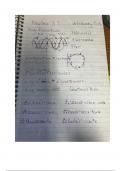Poem Context Summary Themes/Ideas Methods Links to Gatsby
Who so Wyatt was member of Young man challenges Disillusionment, Allegory of hunting for romantic G’s futile pursuit of D, desire
Henry VIII's court, friends & urges them out to frustration & bitterness pursuit transcends class barrier so
rumoured to have been a a chase in love Sonnet - octet & sestet, subtle disillusionment inevitable, though N
suitor of Anne Boleyn No longer interested in Male suffering change 'Who list her hount' only imagines G’s disillusionment
Poems revealed private chasing the deer but can't Women being Aspirant sounds showing pace of ‘I seke to hold the wynde’
thoughts as published stop himself controlled & hunt, as well as breathless effect Elevated female, objectified
after death Revealed at the end that the dehumanised created by frequent conjunctions ‘Cesar’ links to Tom & his control over
Was influenced by deer belongs to Caesar Unattainable love, Eye-rhyme looks close enough to D
Petrarch - poem links futility - 'I seke to hold be recognised but isn't attainable, Elevation of female status: ‘Noli me
heavily to Petrarch's the wynde' like speaker's desire for woman tangere’ & ‘golden girl’
Sonnet 190, but Wyatt Elevation of female ‘Noli me tangere’ - elevation of Eye rhyme ‘behinde/mynde/wynde’ -
transforms it from elegiac female status as links to Jesus‘ deer close enough to be obtainable
tone to one of bitterness Touch me not [for I am not yet but distanced by social barriers, like
& frustration ascended to my father]’ green light in TGG
'for Caesar's I am' - Henry
VIII's jealousy
Sonnet Addressed to a 'fair Speaker begins defining love Ideal view of romantic Shakespearean Sonnet - 3 G’s romantic commitment to D,
116 youth' by what it isn't love quatrains, final couplet, iambic undermined as has materialistic roots.
Marriage was formal In second quatrain, asserts Love transcending time pentameter Rumours around Shakespeare’s
contract so 'marriage of what love is ('an ever fixed Omnia vincit amor Time personified like the grim sexuality & ambiguity of ‘no man ever
true mindes' is more marke') (love conquers all) reaper loved’ may link to class barrier -
idealistic Returns to what love isn't Legalistic tone, disciplined unattainable love
Some speculation ('Times fool') rhetorical structure Love in sonnet transcends all barriers,
regarding Shakespeare's Couplet announces Metaphors showing constancy of love in G’s Romantic imagination does
sexuality speaker's certainty love - 'ever fixed marke', 'star to but in reality cannot
Much of language is every wandring barke' - suggests it Confidence in idealised version of love
ambiguous so isn't is like the North Star ‘marriages of true mindes’ - link to Ch
controversial Cartographical images give sense 8 ‘He felt married to her, that was all’,
of orientation, direction & security idealised, platonic view of marriage,
, Philosophical account of love more than a contract
‘ever fixed marke’ links to green light
Regular sonnet structure conveys
constant love that doesn’t ‘alter’ or
‘shake’, mirrors G’s ‘five years
of unwavering devotion’
Sonnet’s philosophised view contrasts
G’s desire for actual relationship
‘love is not love/Which alters when it
alteration findes’ - shares G’s view
that social situations can alter over
time, but love remains & transgresses
this barrier
‘Lov’s not Times foole’ - positioning of
‘Love’ before ‘Time’ denotes its
superiority, links to G’s belief he can
‘repeat the past’ & ‘fix everything just
the way it was before’, out of love
‘I love you now - isn’t that enough? I
can’t help what’s past’ - G’s love
transcends time, but D’s is only
momentary
The Written when Donne had Speaker tries to persuade Carpe diem Alternates between iambic Male control & female silence - links
Flea lustful, cynical persona woman to have sex w/ him Subordination of the tetrameter & pentameter to T & G discussing D in Ch 7 w/o her
Broke conventions of using graphic pun of flea female Structure of 3 stanzas w/ 3 input
Petrarchan love poetry by Flea becomes multivalent, Carnal desire couplets in each mirrors 3 ‘A sin, nor shame, nor loss of
echoing common speech linked to marriage & church Marriage protagonists (man, woman & flea) maidenhead’ - speaker doesn’t
Metaphysical conceit Woman kills flea so speaker Regular metre - speaker in control acknowledge woman’s choice
brings together 2 vastly alters argument & still tries Imagery of trinity, marriage, ‘when thou yield’st to me’ -
different ideas into one to persuade her church & crucifixion brought in confidence
Ovid's flea set trend for Physical love > spiritual union





